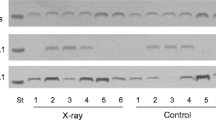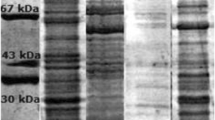Abstract
The major lipid constituent of symbiotic gram-positive bacteria in animals are phosphatidylglycerol, cardiolipin and dihexaosyl diglycerides (DH-DG), whose hydrophobic structures are characteristic of the environments, and the carbohydrate structures of DH-DGs are bacterial species-characteristic. Immunization of rabbits with intestinal lactobacilli generated antibodies against DH-DGs and their modified structures, among which Galα1-6-substituted DH-DG, i.e., Lactobacillus tetrahexaosyl diglyceride (LacTetH-DG), reacted with antibodies more intensely than DH-DG. Whereas, from the 16S-rRNA sequence, the intestinal lactobacilli in murine digestive tracts were revealed to be L. johnsonii, in which LacTetH-DG is present at the concentration of 2.2 ng per 1 × 106 cells. To obtain more accurate estimates of intestinal lactobacilli in several regions of the digestive tract of mice, LacTetH-DG was detected by TLC-immunostaining with anti-Lactobacillus antisera, being found in the stomach, cecum and colon of normal breeding mice, 1.0 × 109, 3.5 × 109 and 7.4 × 109 cells, respectively. Administration of penicillin and streptomycin for 6 days resulted in a reduction in the number of intestinal lactobacilli, the levels being 0 %, 30 % and 4 % of the control ones in the stomach, cecum and colon, respectively, which was associated with the accumulation of the contents in the tracts from the stomach to the cecum and with diarrhea. In addition, a reduced amount of fucosyl GA1 (FGA1) and a compensatory increase in GA1 due to the reduced activity of α1,2-fucosyltransferase in the small intestine and the enhanced discharge of FGA1 into the contents occurred in mice, probably due to the altered population of bacteria caused by administration of penicillin and streptomycin.






Similar content being viewed by others
Abbreviations
- PS:
-
Penicillin and streptomycin
- GA1:
-
Asialo GM1
- FGA1:
-
Fucosyl GA1
- cy:
-
Cyclopropane
- ai:
-
Anteiso
- PG:
-
Phosphatidylglycerol
- CL:
-
Cardiolipin
- GL:
-
Glycolipid
- LJ:
-
Lactobacillus johnsonii
- LI:
-
Lactobacillus intestinalis
- SE:
-
Staphylococcus epidermidis
- LacDH-DG:
-
Lactobacillus dihexaosyl diglycerides
- LacTH-DG:
-
Lactobacillus trihexaosyl diglycerides
- LacTetH-DG:
-
Lactobacillus tetrahexaosyl diglycerides.
References
Iwamori, M., Nakasa, M., Yamazaki, K., Iwamori, Y., Tanaka, K., Aoki, D., Adachi, S., Nomura, T.: Bacterial species-characteristic profiles of molecular species, and the antigenicity of phospholipids and glycolipids in symbiotic Lactobacillus, staphylococcus and streptococcus species. Glycoconj. J. 29, 199–209 (2012)
Iwamori, M., Sakai, A., Minamimoto, N., Iwamori, Y., Tanaka, K., Aoki, D., Adachi, S., Nomura, T.: Characterization of novel glycolipid antigens with an α-galactose epitope in Lactobacilli detected with rabbit anti-Lactobacillus antisera and occurrence of antibodies against them in human sera. J. Biochem. 150, 515–523 (2011)
Iwamori, M., Shibagaki, T., Nakata, Y., Adachi, S., Nomura, T.: Distribution of receptor glycolipids for Lactobacilli in murine digestive tract and production of antibodies cross-reactive with them by immunization of rabbits with Lactobacilli. J. Biochem. 146, 185–191 (2009)
Iwamori, M., Iwamori, Y., Adachi, S., Nomura, T.: Excretion into feces of asialo GM1 in the murine digestive tract and Lactobacillus johnsonii exhibiting binding ability toward asialo GM1. A possible role of epithelial glycolipids in the discharge of intestinal bacteria. Glycoconj. J. 28, 21–30 (2011)
Lin, B., Hayashi, Y., Saito, M., Sakakibara, Y., Yanagisawa, M., Iwamori, M.: GDP-fucose: beta-galactoside alpha1,2-fucosyltransferase, MFUT-II, and not MFUT-I or -III, is induced in a restricted region of the digestive tract of germ-free mice by host-microbe interactions and cycloheximide. Biochim. Biophys. Acta 1487, 275–285 (2000)
Iwamori, M., Domino, S.E.: Tissue-specific loss of fucosylated glycolipids in mice with targeted deletion of α(1,2)fucosyltransferase genes. Biochem. J. 380, 75–81 (2004)
Manual of microbiological culture media, Difco & BBL Manual, Becton, Dickinson and Company, Sparks, MD, USA, 290–293 (2003)
Iwamori, M., Ohta, Y., Uchida, Y., Tsukada, Y.: Arthrobacter ureafaciens sialidase isoenzymes, L, M1 and M2, cleave fucosyl GM1. Glycoconj. J. 14, 67–73 (1997)
Iwamori, M., Kaido, T., Iwamori, Y., Ohta, Y., Tsukamoto, K., Kozaki, S.: Involvement of the C-terminal tail of Arthrobacter ureafaciens sialidase isoenzyme M in cleavage of the internal sialic acid of ganglioside GM1. J. Biochem. 138, 327–334 (2005)
Iwamori, M., Takamizawa, K., Momoeda, M., Iwamori, Y., Taketani, Y.: Gangliosides in human, cow and goat milk, and their abilities as to neutralization of cholera toxin and botulinum type A neurotoxin. Glycoconj. J. 25, 675–683 (2008)
Iwamori, M., Murata, M., Toyoda, M., Iwamori, Y.: Contribution of glycolipids to species-specific antigens on erythrocytes of several animal species as to recognition of antigens with rabbit anti-glycolipids and anti-erythrocyte antisera. Glycoconj. J. 26, 467–476 (2009)
Bradford, M.M.: A rapid and sensitive method for the quantitation of microgram quantities of protein utilizing the principle of protein-dye binding. Anal. Biochem. 72, 248–254 (1976)
Lin, B., Saito, M., Sakakibara, Y., Hayashi, Y., Yanagisawa, M., Iwamori, M.: Characterization of three members of murine α1,2-fucosyltransferases: change in the expression of the Se gene in the intestine of mice after administration of microbes. Arch. Biochem. Biophys. 388, 207–215 (2001)
Tanaka, S., Kobayashi, T., Songjinda, P., Tateyama, A., Tsubouchi, M., Kiyohara, C., Shirakawa, T., Sonomoto, K., Nakayama, J.: Influence of antibiotic exposure in the early postnatal period on the development of intestinal microbiota. FEMS Immunol. Med. Microbiol. 56, 80–87 (2009)
McFarland, L.V.: Meta-analysis of probiotics for the prevention of antibiotic associated diarrhea and the treatment of Clostridium difficile disease. Am. J. Gastroenterol. 101, 812–822 (2006)
Kelly, C.P., LaMont, J.T.: Clostridium difficile–more difficult than ever. N. Engl. J. Med. 359, 1932–1940 (2008)
Szajewska, H., Ruszczyński, M., Radzikowski, A.: Probiotics in the prevention of antibiotic-associated diarrhea in children: a meta-analysis of randomized controlled trials. J. Pediatr. 149, 367–372 (2006)
Bry, L., Falk, P.G., Midtvedt, T., Gordon, J.I.: A model of host-microbial interactions in an open mammalian ecosystem. Science 273, 1380–1383 (1996)
Umesaki, Y., Setoyama, H., Matsumoto, S., Imaoka, A., Itoh, K.: Differential roles of segmented filamentous bacteria and clostridia in development of the intestinal immune system. Infect. Immun. 67, 3504–3511 (1999)
Doron, S.I., Hibberd, P.L., Gorbach, S.L.: Probiotics for prevention of antibiotic-associated diarrhea. J. Clin. Gastroenterol. 42, S58–S63 (2008)
Cremonini, F., Di Caro, S., Nista, E.C., Bartolozzi, F., Capelli, G., Gasbarrini, G., Gasbarrini, A.: Meta-analysis: the effect of probiotic administration on antibiotic-associated diarrhoea. Aliment. Pharmacol. Ther. 16, 1461–1467 (2002)
Johnston, B.C., Supina, A.L., Vohra, S.: Probiotics for pediatric antibiotic-associated diarrhea: a meta-analysis of randomized placebo-controlled trials. CMAJ. 175, 377–383 (2006)
Acknowledgement
This work was supported by JSPS KAKENHI Grant Numbers 24570141, 23592465 and 25462610.
Author information
Authors and Affiliations
Corresponding author
Rights and permissions
About this article
Cite this article
Iwamori, M., Iwamori, Y., Adachi, S. et al. Changes in bacterial glycolipids as an index of intestinal lactobacilli and epithelial glycolipids in the digestive tracts of mice after administration of penicillin and streptomycin. Glycoconj J 30, 889–897 (2013). https://doi.org/10.1007/s10719-013-9494-6
Received:
Revised:
Accepted:
Published:
Issue Date:
DOI: https://doi.org/10.1007/s10719-013-9494-6




